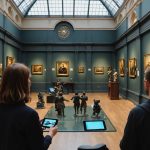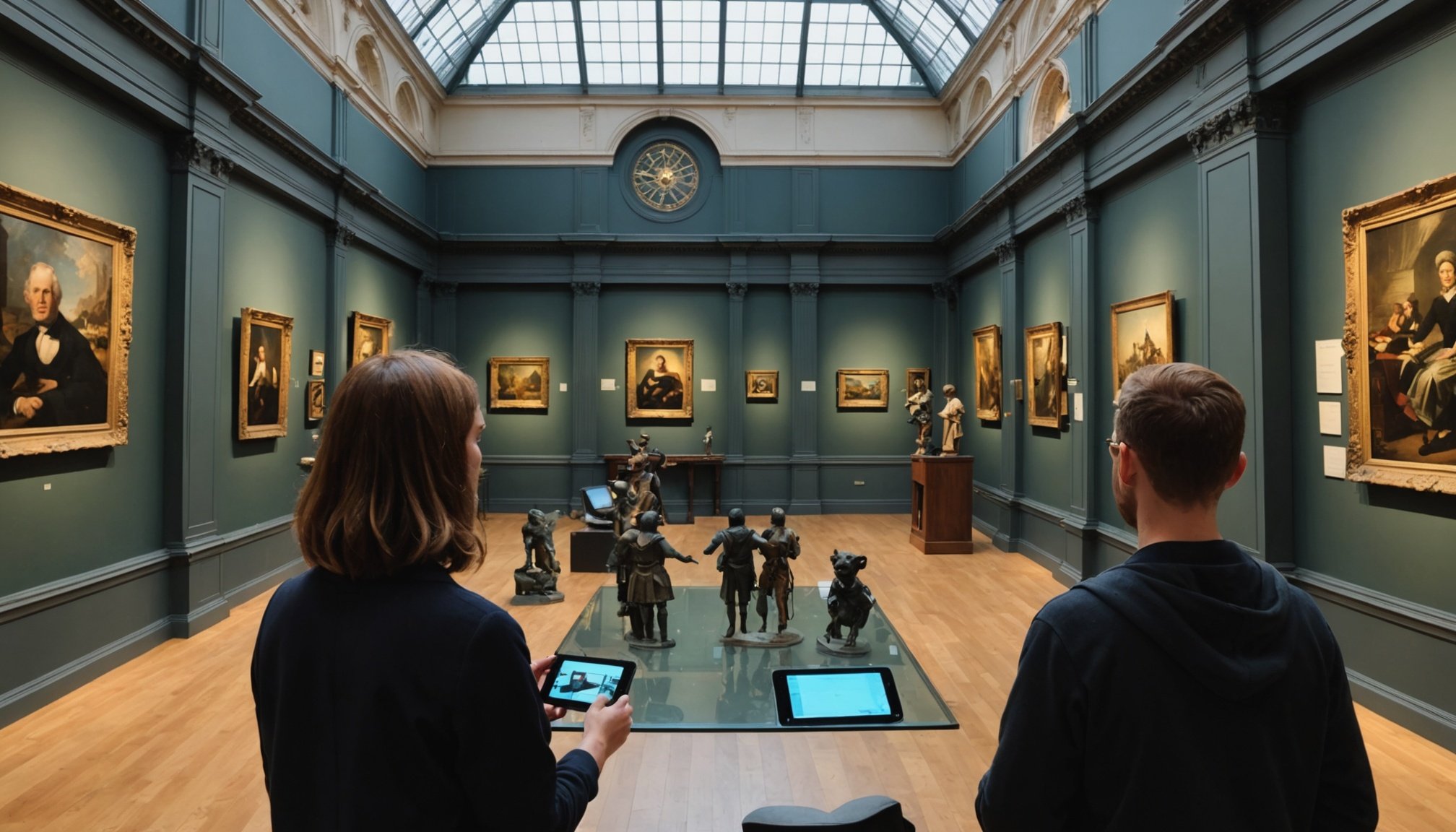Transforming UK Museum Visits: The Ultimate Guide to Leveraging AR for an Unforgettable Experience
In the modern era, museums are no longer static repositories of the past; they have evolved into dynamic, interactive spaces that leverage cutting-edge technology to enhance visitor experiences. One of the most significant innovations in this transformation is the integration of augmented reality (AR) and virtual reality (VR) technologies. Here’s a comprehensive guide on how UK museums are using these technologies to create immersive, unforgettable experiences for their visitors.
The Role of AR and VR in Museum Exhibitions
AR and VR technologies have revolutionized the way museums engage their visitors. These technologies allow museums to transcend traditional exhibit formats, providing an immersive and interactive experience that captivates visitors of all ages.
Also read : Essential Steps for Crafting a Responsive Design for UK Government Websites
Augmented Reality: Bringing Exhibits to Life
Augmented reality integrates digital information into the real world, enhancing the visitor experience in real-time. For instance, the British Museum and the Natural History Museum in London use AR to bring historical artifacts and ancient creatures to life. Visitors can use their smartphones or tablets to visualize scientific phenomena and historical events directly from the exhibits, making the learning experience more engaging and memorable[1].
- **Interactive Visual Guides**: AR provides interactive visual tour guides that offer detailed information about each exhibit.
- **3D Content**: AR displays 3D content in real-world settings, allowing visitors to interact with exhibits in a more immersive way.
- **Real-Time Information**: AR delivers real-time information, enabling visitors to access additional content as they explore the museum.
Virtual Reality: Stepping into History
Virtual reality takes the immersive experience a step further by allowing visitors to step into historical or scientific environments. The Science Museum in London, for example, offers VR experiences that let children explore space or dive into the ocean, interacting with marine life in a way that traditional exhibits cannot match[1].
Also to read : Unlocking Marketing Insights: Top Data Visualization Strategies for the UK”s Tourism Industry
- **Immersive Environments**: VR creates immersive environments that simulate historical or scientific settings.
- **Interactive Experiences**: VR allows visitors to interact with virtual objects and environments, enhancing their understanding and engagement.
- **Educational Value**: VR experiences are designed to be educational, making complex concepts more accessible and engaging.
Creating Family-Friendly and Immersive Experiences
UK museums are prioritizing the creation of family-friendly environments that cater to the interests and developmental stages of children. This approach ensures that each visit is both educational and enjoyable.
Interactive Exhibits for Children
The Natural History Museum is a prime example of how interactive exhibits can make history and science accessible and exciting for children. Young visitors can dig for fossils, interact with life-size dinosaur models, and participate in AR experiences that bring ancient creatures to life. These activities make learning tangible and fun, encouraging children to ask questions and explore further[1].
- **Hands-On Activities**: Interactive exhibits such as fossil digging and dinosaur model interactions encourage hands-on learning.
- **AR Experiences**: AR experiences bring ancient creatures to life, making history more engaging and interactive.
- **Takeover Days**: Special events where children can take on roles within the museum, such as tour guides or exhibit designers, provide a behind-the-scenes look and foster a deeper connection to the museum.
Personalizing Visitor Experiences with Technology
Technology is not just about enhancing exhibits; it also plays a crucial role in personalizing the visitor experience. Advanced visitor profiling and AI-driven systems are being used to tailor content to individual preferences.
Advanced Visitor Profiling
Museums are using smart badges and telemetry-driven systems to track visitor interactions and movements. This data is used to create personalized content delivery, ensuring that each visitor receives information that is relevant to their interests. For example, the system can identify “Interactive Kids” who are attracted to interactive exhibits and deliver content in the form of images, audio, and video to engage them effectively[2].
- **Visitor Groups**: Identifying different visitor groups such as In-Depth Movers, Interactive Kids, and Teen Trendsetters helps in delivering targeted content.
- **Smart Badges**: Smart badges track visitor interactions and movements, providing valuable data for personalization.
- **Content Delivery**: Personalized content delivery ensures that visitors receive information that aligns with their interests and preferences.
AI-Driven Personalization
AI applications in museums can recommend exhibits based on individual preferences, predict what each visitor seeks, and even provide real-time translations for international guests. The Museum of Tomorrow in Rio de Janeiro, for instance, uses an AI-powered digital assistant called IRIS+ to personalize the visitor experience. IRIS+ knows which sectors remain unvisited and stores this information for future visits, creating recommendations and sending updates to users via the internet[4].
- **Recommendations**: AI recommends exhibits based on individual preferences, ensuring a tailored experience.
- **Real-Time Translations**: AI provides real-time translations, enhancing the experience for international visitors.
- **Personalized Feedback**: AI-driven systems collect and process visitor feedback, helping to improve the overall experience.
The Impact of AR on Climate Change Education
Museums are also leveraging AR and VR to educate visitors about critical issues such as climate change. By presenting complex scientific concepts in an accessible and engaging way, museums help visitors understand the importance of environmental stewardship.
Interactive Climate Change Exhibits
The Natural History Museum has developed a range of exhibits that focus on climate change and its impacts. Interactive displays allow visitors to explore the causes and consequences of global warming, while AR and VR technologies provide immersive experiences that highlight the urgency of the issue. These exhibits enable visitors to visualize the effects of climate change on different ecosystems and learn about steps they can take to protect the planet[1].
- **Interactive Displays**: Interactive displays explain the causes and consequences of global warming.
- **Immersive Experiences**: AR and VR technologies provide immersive experiences that highlight the urgency of climate change.
- **Educational Value**: These exhibits educate visitors about the importance of environmental stewardship and inspire action.
Practical Insights and Actionable Advice
For museums looking to integrate AR and VR into their exhibitions, here are some practical insights and actionable advice:
Embrace Digital Technologies
Museums should embrace digital technologies as a core part of their strategy. This includes investing in AR and VR hardware, developing interactive exhibits, and integrating smart badges and AI-driven systems to personalize the visitor experience[1][4].
- **Invest in Hardware**: Invest in AR and VR hardware to create immersive experiences.
- **Develop Interactive Exhibits**: Design exhibits that are interactive and engaging.
- **Integrate Smart Technologies**: Use smart badges and AI-driven systems to personalize the visitor experience.
Collaborate with Experts
Collaborating with scientists, environmental organizations, and technology experts can help museums develop exhibits that are both educational and engaging. For example, the Natural History Museum collaborates with scientists to develop climate change exhibits that are accurate and impactful[1].
- **Collaborate with Scientists**: Work with scientists to ensure the accuracy and educational value of exhibits.
- **Partner with Technology Experts**: Partner with technology experts to develop innovative AR and VR experiences.
- **Engage with Environmental Organizations**: Collaborate with environmental organizations to develop exhibits that highlight critical issues like climate change.
The integration of AR and VR technologies in UK museums is transforming the visitor experience, making it more immersive, interactive, and educational. By leveraging these technologies, museums can create family-friendly environments, personalize visitor experiences, and educate visitors about critical issues such as climate change. As technology continues to evolve, it is clear that the future of museum visits will be shaped by these innovative approaches, ensuring that cultural heritage remains accessible and engaging for generations to come.
Table: Comparison of AR and VR Technologies in Museums
| Technology | Description | Examples | Benefits |
|---|---|---|---|
| Augmented Reality (AR) | Integrates digital information into the real world | British Museum, Natural History Museum | Enhances real-world exhibits, provides real-time information, interactive visual guides |
| Virtual Reality (VR) | Creates immersive environments that simulate historical or scientific settings | Science Museum | Provides immersive experiences, interactive environments, educational value |
| Smart Badges | Track visitor interactions and movements to personalize content delivery | Advanced Visitor Profiling | Personalized content delivery, enhanced visitor engagement, data collection for improvement |
| AI-Driven Systems | Recommend exhibits based on individual preferences, provide real-time translations | Museum of Tomorrow | Personalized recommendations, real-time translations, improved visitor feedback |
Quotes from Experts
- “The integration of AR and VR technologies allows children to step into history and interact with exhibits in unprecedented ways.” – [Source: How do UK museums make history accessible for children with interactive exhibits?][1]
- “AI applications in museums can make everything feel super customized, tailoring content based on individual preferences and predicting exactly what each visitor seeks.” – [Source: How Can UK Museums Utilize AI for Enhanced Visitor Experiences?][4]
- “Museums and zoos utilize AR to educate and entertain audiences by providing interactive visual tour guides and displaying 3D content in real-world settings.” – [Source: Augmented Reality Technology: A Key Driver Transforming the Museums, Historical Sites, Zoos, And Parks Market 2024][5]
By embracing these technologies and strategies, UK museums are not only enhancing the visitor experience but also ensuring that cultural heritage remains vibrant and accessible for future generations.











